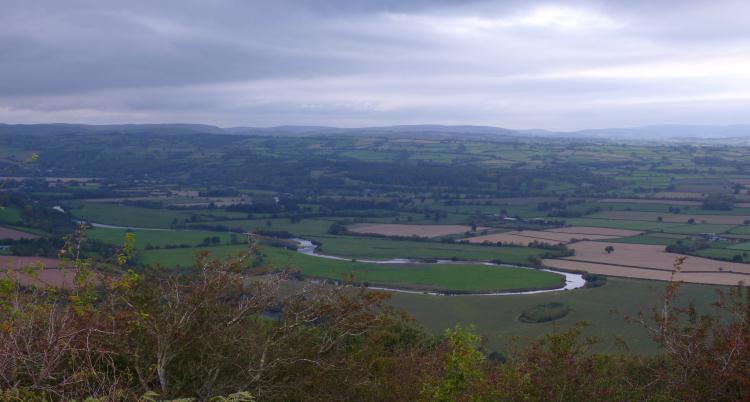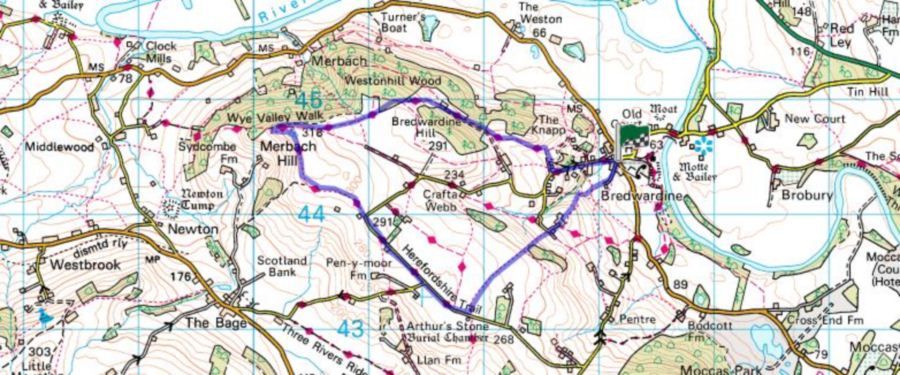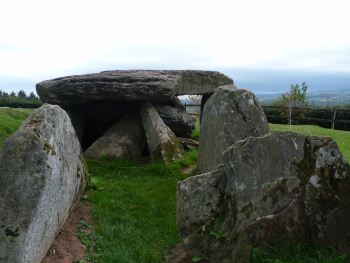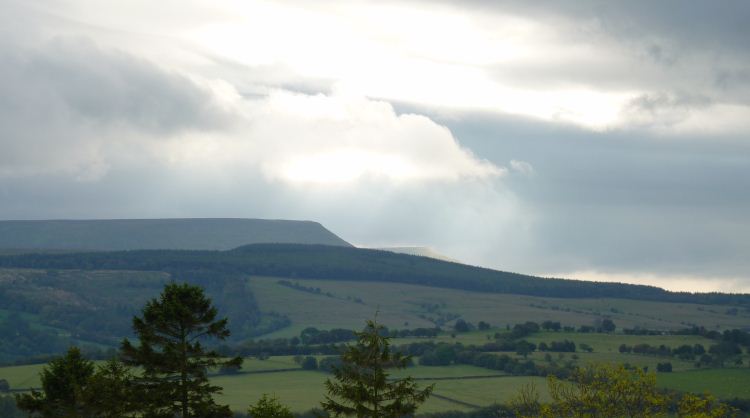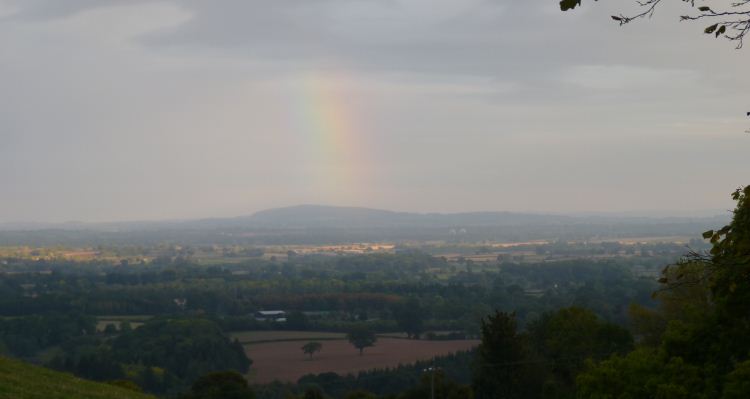This is a very pretty walk. Apart from the initial uphill slog, there are wonderful views, particularly over the Black mountains and Hay Bluff, but also of the Malverns and the Herefordshire countryside. On the descent you have excellent views of the many meanders the river Wye takes around here – if you look hard enough you may even see an abandoned one (meander that is).
SUMMARY
- Grade: Moderate-Difficult. Although much of the route is easy, there is one steep longish grassy ascent, and one steep (potentially muddy) downhill stretch.
- Length: 5.5 miles
- Key Features: King Arthur’s stone – a Neolithic tomb. Fantastic views for much of the route, with 360 degree ones from the top
- Refreshments: Red Lion hotel at Bredwardine
For an interactive version of this map click the image above or here
Park in Bredwardine. As you look at the Red Lion hotel, take the track which goes to the left of the building.
Continue to follow the yellow arrows, until – after you’ve gone through the first large field- you come to a place where there are two stiles not far from each other. Take the left hand one, and bear diagonally left uphill into the corner of the field, where another stile is rather hidden under vegetation. Follow the yellow arrows until you reach a place where there is an old farmhouse on your right and you go through a metal gate. After going through this gate, turn right through another metal gate, and then turn left along a track. About 20 yards along the lane, and opposite a cottage called Cherry Orchard, there is a stile on the right which you go over.
After a particularly steep grassy uphill climb there is a stile (which when we were there you have to get over rather precariously, by standing on an upturned milk crate). After this you cross over a broad grassy belt about 15 yards wide , and then go over another stile and straight on. On our walk potatoes had just been lifted from the field, so ‘straight on’ me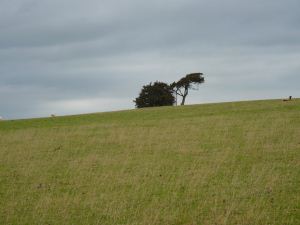 ant finding our way along the furrows.
ant finding our way along the furrows.
Carry on following the yellow arrows until you get to a small asphalted road. You won’t be able to miss ‘King Arthur’s stone’ – which is in fact a Neolithic tomb. After you have looked at this, proceed right along the road, following the Herefordshire Trail. This goes straight on through a metal gate onto a drive, at the point where the lane takes a sharp right. After a few yards the drive that you are on loops back on itself, but you continue straight ahead and keep to the right of the line of trees.
After a while you will find the path begins to take you off diagonally to the right, towards two gnarled hawthorn trees on the skyline. The tre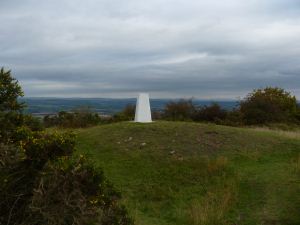 e on the right is the shape of an overgrown bonsai. You go between the two trees, taking in the magnificent views, and straight ahead you will see a white trig point.To get to this you go through a gate and onto Merbach Common.
e on the right is the shape of an overgrown bonsai. You go between the two trees, taking in the magnificent views, and straight ahead you will see a white trig point.To get to this you go through a gate and onto Merbach Common.
From the trig point go back the way you came for about 10 yards, and then turn right and aim downhill. You will come to a place where the path you are one apparently divides into two. This is where the Herefordshire trail meets the Wye valley walk, and you want to go right following the Wye valley walk all the way into Bredwardine. The path is quite well signposted with Wye valley walk signs, except just past Woolla farm. Aas you walk down the farm drive keep your eyes open for the Wye valley walk sign on the telephone pole, which directs you leftwards across the field and almost under a rather statuesque oak tree.
The walk
We did this walk on a day in September which threatened rain – but fortunately this didn’t materialise. It did mean that there were amazing skies, with light scraping past great grey clouds. The views were fantastic, particularly considering that the hill is only about 300 metres high. Going towards the top of Merbach the view on your left, of a great grey slab ending in an abrupt drop, is the Black Mountains leading into Hay Bluff.
One thing which did sadden me a little on the walk was the way that King Arthur’s stone has been penned in by a mean little wooden fence. This didn’t even keep people from climbing on the stone, since there was a gap so that people could have a closer look. I have no idea what purpose this fence is supposed to serve. I much prefer ancient monuments of this type to be an integral and uninterrupted part of the landscape, cutting them off seems like hacking off the roots of an ancient tree.
The only people we met on this walk were busy picking sloes, which have taken over from the slowly withering blackberries in the hedgerows. We were always told never to pick sloes until after the first frost – certainly for the best sloe gin – but I guess people just stick them in the freezer for a while before using them.
I was surprised to see so many harebells on this walk, it seemed too late in the year, but they were clearly thriving – as were the many stag beetles which punctuated the path down the hill. And at the end of the walk we were honoured with a rainbow spotlighting the Herefordshire plains.


 Wye Walker
Wye Walker 